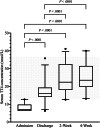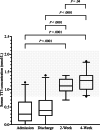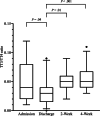Thyroid function tests during nonthyroidal illness syndrome and recovery in acutely ill dogs
- PMID: 38032018
- PMCID: PMC10800236
- DOI: 10.1111/jvim.16947
Thyroid function tests during nonthyroidal illness syndrome and recovery in acutely ill dogs
Abstract
Background: Nonthyroidal illness syndrome (NTIS) can result in thyroid function test alterations that mimic hypothyroidism. The duration of NTIS-induced changes in dogs is not well-described.
Objectives: Document alterations in thyroid function tests during NTIS and recovery, and the time necessary for their resolution.
Animals: From 103 dogs sampled, 25 euthyroid dogs with acute, resolvable illness having a low serum total thyroxine (TT4) concentration on admission were analyzed.
Methods: Prospective observational study. Serum TT4 concentration was measured in 103 dogs within 4 hours of admission. If below the reference interval (RI), subsequent serum samples were obtained every 24 hours from admission until discharge (acute phase) and at 2 weeks and 4 weeks after discharge (recovery phase). Serum samples were submitted for batch measurement of serum TT4, free thyroxine (fT4), total 3,5,3'-triiodothyronine (TT3), and thyroid-stimulating hormone (TSH) concentrations.
Results: In the cohort of dogs analyzed, serum TT4, TT3, and fT4 concentrations were below the RI in 100%, 80%, and 16% at admission; 20%, 80%, and 0% at discharge; 4%, 8%, and 0% at 2 weeks; and 0%, 0%, and 0% at 4 weeks, respectively. Serum TSH concentration was within the RI in 100% at admission and discharge, and above the RI in 4% and 12% at 2 weeks and 4 weeks, respectively.
Conclusions and clinical importance: Naturally occurring NTIS in dogs induces alterations in thyroid function tests during acute illness and recovery. Measurement of serum TT4 concentration 2 to 4 weeks after discharge or serum fT4 concentration by ED during illness is recommended for accurate assessment of thyroid function in acutely ill dogs.
Keywords: dog; hypothyroidism; normalization; sick.
© 2023 The Authors. Journal of Veterinary Internal Medicine published by Wiley Periodicals LLC on behalf of American College of Veterinary Internal Medicine.
Conflict of interest statement
Authors declare no conflict of interest.
Figures







Similar articles
-
Total thyroxine, triiodothyronine, and thyrotropin concentrations during acute nonthyroidal illness and recovery in dogs.J Vet Intern Med. 2024 May-Jun;38(3):1345-1352. doi: 10.1111/jvim.17059. Epub 2024 Apr 23. J Vet Intern Med. 2024. PMID: 38654457 Free PMC article.
-
Assessment of thyroid function in dogs with low plasma thyroxine concentration.J Vet Intern Med. 2007 Jan-Feb;21(1):25-32. doi: 10.1892/0891-6640(2007)21[25:aotfid]2.0.co;2. J Vet Intern Med. 2007. PMID: 17338146
-
Thyroid function tests in healthy kittens aged between 2 and 16 weeks.J Feline Med Surg. 2024 Oct;26(10):1098612X241275262. doi: 10.1177/1098612X241275262. J Feline Med Surg. 2024. PMID: 39466883 Free PMC article.
-
Measurement of serum free thyroid hormone concentrations: an essential tool for the diagnosis of thyroid dysfunction.Horm Res. 1996;45(3-5):142-7. doi: 10.1159/000184777. Horm Res. 1996. PMID: 8964573 Review.
-
[Abnormal thyroid markers in critically ill patients-harmless irritation or a real problem?].Med Klin Intensivmed Notfmed. 2024 Jul 17. doi: 10.1007/s00063-024-01161-9. Online ahead of print. Med Klin Intensivmed Notfmed. 2024. PMID: 39020096 Review. German.
Cited by
-
Total thyroxine, triiodothyronine, and thyrotropin concentrations during acute nonthyroidal illness and recovery in dogs.J Vet Intern Med. 2024 May-Jun;38(3):1345-1352. doi: 10.1111/jvim.17059. Epub 2024 Apr 23. J Vet Intern Med. 2024. PMID: 38654457 Free PMC article.
References
-
- Docter R, Krenning EP, de Jong M, Hennemann G. The sick euthyroid syndrome: changes in thyroid hormone serum parameters and hormone metabolism. Clin Endocrinol (Oxf). 1993;39:499‐518. - PubMed
-
- De Groot LJ. Dangerous dogmas in medicine: the nonthyroidal illness syndrome. J Clin Endocrinol Metab. 1999;84:151‐164. - PubMed
-
- Kantrowitz LB, Peterson ME, Melián C, Nichols R. Serum total thyroxine, total triiodothyronine, free thyroxine, and thyrotropin concentrations in dogs with nonthyroidal disease. J Am Vet Med Assoc. 2001;219:765‐769. - PubMed
-
- Mooney CT, Shiel RE, Dixon RM. Thyroid hormone abnormalities and outcome in dogs with non‐thyroidal illness. J Small Anim Pract. 2008;49:11‐16. - PubMed
-
- Ramsey IK, Evans H, Herrtage ME. Thyroid‐stimulating hormone and total thyroxine concentrations in euthyroid, sick euthyroid and hypothyroid dogs. J Small Anim Pract. 1997;38:540‐545. - PubMed
Publication types
MeSH terms
Substances
Grants and funding
LinkOut - more resources
Full Text Sources
Medical

